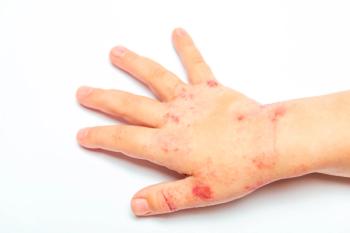
- Consultant for Pediatricians Vol 5 No 8
- Volume 5
- Issue 8
Photo Essay: Cure Worse Than the Disease? Toxic Epidermal Necrolysis
This 18-year-old girl had been taking divalproex for seizure disorder for 2 years. Because she had gained weight while taking this medication, the patient asked for another drug. Her neurologist prescribed lamotrigine. Ten days after starting the new agent, a generalized, painful, pruritic, ery- thematous dermatitis; fever; and sore throat developed.
This 18-year-old girl had been taking divalproex for seizure disorder for 2 years. Because she had gained weight while taking this medication, the patient asked for another drug. Her neurologist prescribed lamotrigine. Ten days after starting the new agent, a generalized, painful, pruritic, ery- thematous dermatitis; fever; and sore throat developed.
The patient was initially treated with a methylprednisolone injection and antihistamines. Within a day, her skin began to blister. She was then moved to a burn unit, and treated with intravenous immunoglobulin therapy. A skin biopsy revealed a subepidermal split.
The clinical picture and biopsy results are consistent with toxic epidermal necrolysis (TEN)--the most severe variant of a group of skin reactions that include Stevens-Johnson syndrome and bullous erythema multiforme. Histopathologic examination is necessary to differentiate the disorders. Mortality associated with TEN ranges from 30% to 40%; septicemia from epithelial loss is the primary cause of death.1
TEN usually occurs in adults. Most cases are drug-induced and usually develop within the first 8 weeks of therapy. The most widely implicated drugs are sulfonamides, anticonvulsants, allopurinol, antiretroviral medications, and corticosteroids.2 The rash is very painful. Frequently affected mucous membranes include the oropharnyx, eyes, and genitalia. Lesions predominate on the torso and face; the scalp is spared.
Treatment consists of removal of the causative agent, intensive fluid and electrolyte management, pain control, and meticulous skin care. Although controversial, the use of intravenous immunoglobulin has been helpful in some cases.3
After intense burn therapy, this patient survived without subsequent complication. She was discharged 2 weeks after admission and given a prescription for levetiracetam.
(Case and photograph courtesy of Rebecca Galante, MD, of Hammond, Ind.)
References:
REFERENCES:
1
. Amon RB, Dimond RL. Toxic epidermal necrolysis. Rapid differentiation between staphylococcal- and drug-induced disease.
Arch Dermatol.
1975;111: 1433-1437.
2.
Prendiville J. Stevens-Johnson syndrome and toxic epidermal necrolysis.
Adv Dermatol.
2002;18:151-173.
3.
Schwartz RA. Toxic epidermal necrolysis.
Cutis.
1997;59:123-128.
Articles in this issue
over 19 years ago
Photoclinic: Tinea Capitisover 19 years ago
Photoclinic: Pathologic Fracture of an Aneurysmal Bone Cystover 19 years ago
Pediatric Chest Pain: Keys to the Diagnosisover 19 years ago
Juvenile Plantar Dermatosis and Seborrheic Dermatitisover 19 years ago
Case in Point: Infant With an "Atypical Mole"over 19 years ago
Treatment of ADHD: A Developmental Approachover 19 years ago
Photoclinic: Schizencephalyover 19 years ago
ADHD: Answers to Questions Physicians Often AskNewsletter
Access practical, evidence-based guidance to support better care for our youngest patients. Join our email list for the latest clinical updates.








